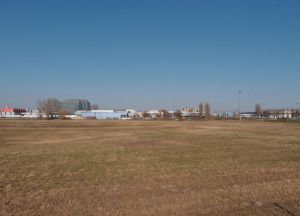
WIEN-SIEMENSAECKER
CATEGORY
Architectural
TEAM REPRESENTATIVE
Architect/Urban Planner/Landscaper
LOCATION WIEN
Floridsdorf
POPULATION
1.750.000
STRATEGIC SITE
84 ha Site of Project 6,7/11,7/8,4 ha
SITE PROPOSED BY
City of Wien
OWNER(S) OF THE SITE
Siemens
COMMISSION AFTER COMPETITION
urban study + involvement in the implementation
process of the architectural pilot project
Detailed information / Registration
www.europan-europe.eu

RE-WEAVING LIVING WITH TRANSFORMING WORKING ENVIRONMENTS
HOW THE SITE CAN CONTRIBUTE TO THE ADAPTABLE CITY?
Due to the intense growth of Vienna‘s population housing has to be conceived as an opportunity to intensify suburban areas in a twofold adaptive process: on the one hand the program of housing itself has to be modified in order to adapt to the demands of „unifying“ contradictory scales and uses. On the other hand, the mid-term transformation process of industrial developments could lead to new urban qualities owing to the lack of conflicts between housing and living-friendly environments of certain innovative industrial developments.
CITY STRATEGY
Being confronted with a strong growth in population - every year 20.000 new inhabitants - Vienna focusses on various scenarios of densification. This includes the consolidation of the inner city (e.g. the development of railway station areas) as well as the planning of a large satellite-towns (Seestadt Aspern). Another focus is the conversion of large diffused areas in the outer districts where the potential of growth goes hand in hand with the challenge of introducing a „new idea of city“. The gradual conversion of large industrial estates to more compact units provides the opportunity to create more sustainable urban environments.
SITE DEFINITION
A patchwork of housing estates, factories, research centres, single family homes, and agricultural areas characterizes the surroundings of the site, which itself is an agricultural remnant, owned by Siemens Company. A process of gradual conversion is taking place in the area, from industrial areas to more compact, mixed use environments, such as the development of the gasworks area further north of the site, and the Siemens area adjacent to the project site. Although a bus line and a local train provide public transport service, the car still is the dominant means of mobility in this area.
ADAPTABILITY : MAIN ELEMENTS TO TAKE INTO ACCOUNT
There is no dominant typology but a diversity of types with different life-cycles and adaptivity-processes. The single family homes are exposed to an inner transformation due to the structural change of its dwellers. The factories have shorter life cycles and invite for concepts of programmatic adaptation, converting from industrial to research facilities, integrating the surroundings in a more productive way.
Could the „Green City“ of Siemens with its connective green areas become the starting point for a process in which the in-between spaces adapt to the demands of different user groups, ranging from dwellers to workers (white and blue collar) and visitors? Could the „Green City“ of Siemens become the starting point of a typological adaptation following the demands of a more compact building concept which allows a new proximity and synergy between working and living? Could the ongoing „compression“ of the Siemens area trigger another form of growth, one that allows a synergetic „coming-together“ of the rhythms of living, recreating, moving, and working?
